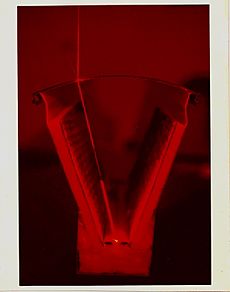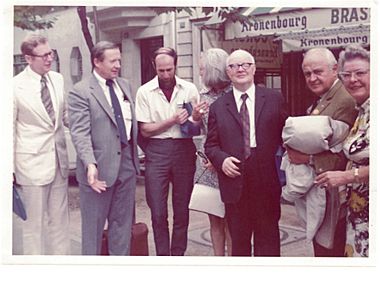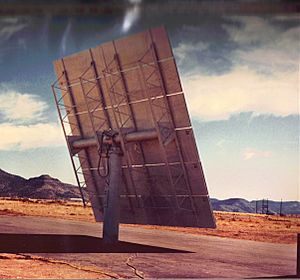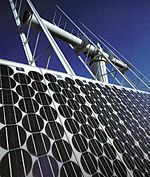Leonard L. Northrup Jr. facts for kids
Quick facts for kids
Leonard L. Northrup Jr.
|
|
|---|---|
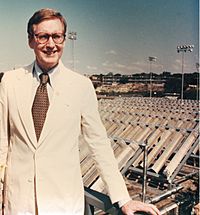 |
|
| Born | March 18, 1918 Houston, Texas, U.S.
|
| Died | March 24, 2016 (aged 98) Dallas, Texas, U.S.
|
| Nationality | American |
| Alma mater | Southern Methodist University University of Denver Harvard University |
| Known for | Active and Passive Solar technology, Stone Architecture |
| Awards | ASHRAE American Institute of Architects Patents |
| Scientific career | |
| Fields | Solar engineering |
| Institutions | NASA Sandia Labs Lawrence Livermore National Laboratory US Department of Energy Energy Research and Development Administration |
| Influences | John Yellott Harry Tabor Maria Telkes |
Leonard "Lynn" L. Northrup Jr. (March 18, 1918 – March 24, 2016) was an American engineer. He was a pioneer in making solar thermal energy useful for everyday life. Solar thermal energy uses the sun's heat to create power.
Northrup was inspired by experts like John Yellott, Maria Telkes, and Harry Tabor. His company designed and built some of the first commercial solar products. These included solar water heaters and solar-powered air conditioning. He also worked on large-scale solar power systems. Northrup held 14 patents for his inventions. His company eventually became part of BP Solar, one of the world's largest solar energy companies.
Contents
- Lynn Northrup's Early Life and Education
- Pioneering Air Conditioning for Cars and Homes
- Bringing Solar Thermal Technology to the Market
- First Commercial Tracking Solar Collectors
- Developing Solar Power Towers
- The Rise of ARCO Solar
- Work in Real Estate and Architecture
- Awards and Recognition
- Northrup's US Patents
- Film Appearances
- See also
Lynn Northrup's Early Life and Education
Lynn Northrup Jr. was born in Texas. His father, L. L. Northrup Sr., was also an inventor. His mother, Dolly McKaskle Northrup, was a business owner.
Lynn went to Woodrow Wilson High School in Dallas, Texas. He earned a Bachelor of Arts degree from Southern Methodist University. He later received a Master of Science from the University of Denver. He also earned a Master of Business Administration from Harvard Business School. During and after World War II, Northrup served as a captain in the United States Army Corps of Engineers.
Pioneering Air Conditioning for Cars and Homes
After World War II, Northrup worked for a company called Storm Vulcan. There, he invented a machine to clean airplane engines. He also started a project to put air conditioning in cars. He placed the cooling equipment in the car's trunk. Then, he sent the cool air through tubes in the car's ceiling.
Engineers from General Motors were very interested in his idea. They copied his system for Cadillac cars in the late 1940s. Car air conditioning units based on his design were made in Texas for many years. Northrup also sold some of the first air conditioning units for windows. These were made by the Curtis Mathes Corporation.
Northrup built one of the first homes in the United States with central air conditioning. He then started a company to install air conditioning in homes and businesses. His company became a major supplier of air conditioning parts. He also created a business to manage and clean air filtration systems.
Bringing Solar Thermal Technology to the Market
In the late 1960s, Northrup bought Donmark Corporation. This company made air conditioning and heating equipment. Northrup focused on making "all electric" heating and cooling systems. He built factories in Dallas and Hutchins, Texas. He sold these systems mainly to apartment builders. He worked to make these systems affordable to install.
In the mid-1970s, Northrup wanted to make air conditioning systems even more efficient. He explored new ideas like geothermal heat pumps. He also looked at using scroll compressors in air conditioning units. These compressors help systems use less energy. Today, scroll compressors are standard in high-efficiency air conditioners.
In the early 1970s, before the Arab Oil Embargo, Northrup became interested in solar thermal systems. He saw their potential for heating water for homes and swimming pools. Other countries already used these systems, especially where sunlight was plentiful and energy was expensive.
Northrup began testing solar collectors that could heat air. He worked with Professor John Yellott, a solar expert. Yellott helped him understand how different surfaces absorb and release heat. They also studied how different glass materials trap heat, like a "greenhouse effect".
Northrup also hired Maria Telkes, an expert in phase change materials. These materials can store heat. He also consulted with Harry Tabor, an Israeli solar pioneer. Tabor advised him on special coatings for solar panels, like "black chrome."
This research led to commercial solar water heaters and solar pool heaters. Northrup Energy sold these products directly and through dealers. They were very successful in Hawaii, where solar thermosiphon systems worked well. With low-temperature products in production, Northrup then aimed for higher temperatures. This meant finding ways to concentrate sunlight and track the sun's movement.
First Commercial Tracking Solar Collectors
Northrup's big invention was a special solar collector. It used a long, curved acrylic fresnel lens to focus sunlight. This lens could concentrate sunlight about 12 times onto a copper tube. The tube was coated with a special "black chrome" surface.
This solar array was about 10 feet long. It automatically tracked the sun's movement from east to west during the day. The tracking system was clever. It used two photoelectric cells with a barrier between them. These cells sent signals to a control board that moved the array. When the cells received equal light, the array was pointing directly at the sun.
This system allowed the array to track the sun and create a lot of heat. Tests showed that these collectors gathered twice as much usable energy at higher temperatures than other solar panels.
These solar arrays became popular. They were used to power absorption refrigeration systems. Large installations were built at Trinity University in San Antonio, Texas, and at Frenchman’s Reef Hotel in St. Thomas. They were also sold to famous people like actors Steve McQueen and Stuart Whitman, and environmentalist Robert Redford.
The success of these collectors was partly due to grants from the Department of Energy. Northrup, Inc. received a lot of publicity. They were featured on the cover of Popular Science Magazine and in Fortune Magazine. These articles highlighted how Northrup's collectors produced higher temperatures than most other solar systems. These concentrating collectors were among the first successful "east-west" tracking solar collectors. Their basic design is still used today in modern solar systems.
Developing Solar Power Towers
After his success with concentrating collectors, Northrup wanted to achieve even higher temperatures. He turned his attention to "heliostats." These are mirrors that track the sun and focus its rays onto a central boiler. This is the idea behind solar thermal power towers.
At the time, the most advanced power tower was an experimental one in France. Northrup attended a conference there in 1973. He went with Professor Yellott and Floyd Blake, an aerospace engineer interested in solar research.
This led Northrup to hire Blake and 16 other engineers. They set up a research center in Colorado. The first Northrup, Inc. mirror array, called "Northrup I," was built with company funds and a grant from Texas. It used many flat mirrors with a weather-proof backing. Each mirror was angled to focus sunlight onto the central tower. This required many calculations and special computer-controlled gears, which Northrup designed. Floyd Blake recalled Northrup's dedication, even climbing ladders and using helicopters to check the mirrors.
Northrup, Inc. quickly became a leader in power tower and heliostat installations. They received grants from NASA Huntsville, Lawrence Livermore National Laboratory, Sandia National Laboratories, and the United States Department of Energy. Most of their heliostats, including the commercial "Northrup II" model, were developed under contract for the U.S. Department of Energy. These heliostats could focus sunlight to create temperatures up to 2,000 degrees. Northrup, Inc. also partnered with Bechtel Corp., which designed the steam boiler for the power towers.
The Rise of ARCO Solar
By the late 1970s, Northrup Energy was a top developer of solar thermal technology. This caught the attention of large companies, including Atlantic Richfield Company, or "ARCO." ARCO's chairman, Robert O Anderson, was very interested in solar energy. He visited Northrup Energy's facilities.
Northrup, Inc. merged with Atlantic Richfield. ARCO Ventures then changed its name to ARCO Solar. The Northrup Energy team, led by Floyd Blake and Jerry Anderson, went on to design and build some of the first commercial solar power towers. One famous project was "Solar One" near Barstow, California. The heat from another project was used to create steam for oil recovery and electricity. Some heliostats were built to track the sun directly with photovoltaic cells. These cells convert sunlight into electricity for the power grid.
The "Solar One" unit near Barstow was the largest solar electric power plant in the world. It was later moved to Europe to become Europe's first commercial solar thermal power station. Northrup and Blake were featured in a documentary about solar energy called Harnessing the Sun.
ARCO Solar later focused more on solar photovoltaic systems. It was sold first to Siemens, then to British Petroleum (now "BP"). BP Solar became the largest solar photovoltaic company in the world.
Northrup's designs for flat plate solar collectors, tracking collectors, and heliostats are still used today. They form the basis of modern solar thermal technology. To honor Professor John Yellott's contributions, Northrup funded a special position at Arizona State University in Yellott's name. Northrup himself has been recognized for his work by the American Institute of Architects and the American Society of Heating, Refrigerating and Air-Conditioning Engineers.
Work in Real Estate and Architecture
After Northrup, Inc. merged with ARCO, Northrup started working in real estate. He bought a large area of land in downtown Dallas. He planned to build a market there with James Rouse's Enterprise Development Company. This project was later sold. Northrup also helped fund Rouse's Enterprise Foundation, which builds affordable housing.
Northrup also bought land around Lewisville Lake in Texas. Part of this land later became the city of The Colony. He also acquired 5,000 acres near San Antonio, Texas, for his family.
Northrup then started American Limestone. This company used Texas limestone in new ways for building exteriors. They developed a patented method using thin limestone panels as a veneer. These panels were attached to a metal grid without mortar. This made it popular to use rough-cut limestone as a thin covering for homes and businesses. It was used on stores, churches, banks, and public buildings.
Northrup also used huge blocks of limestone for their natural heating and cooling abilities. He famously donated the stone and helped design the construction for the Cistercian Chapel in Irving, Texas. This chapel uses a classic design and a method of building with mortar-less stone. The architect, Gary Cunningham, said they wanted to build a church that would last for 900 years.
Awards and Recognition
- Engineering Achievement Award from the American Society of Heating, Refrigeration, and Air Conditioning Engineers.
- Citation of Honor Award from the American Institute of Architects. This award recognized his pioneering work in making solar energy a real industry.
- Honorary Member of Beta Beta Beta, a biological honor society. This was for his important contributions and service to society.
Northrup's US Patents
| Date Filed | Patent No | Description |
|---|---|---|
| October 4, 1951 | , US 2825349 | Parts Cleansing Machines |
| April 30, 1954 | , US 2838289 | Means for Cleaning Equipment |
| April 9, 1973 | , US 3852695 | Electrical Switching System |
| April 16, 1973 | , US 3912903 | Electric Heating Device for Air Duct |
| September 3, 1974 | , US 3977467 | Air Conditioning Module |
| March 20, 1975 | , US 3991741 | Roof-lens Solar Collector |
| September 10, 1975 | , US 4022186 | Compound Lens Solar Energy System |
| December 1, 1977 | , US 4180985 | Air Conditioning System with Regeneratable Desiccant Bed |
| October 23, 1978 | , US 4227513 | Solar System Having Improved Heliostat and Sensor Mountings |
| November 13, 1978 | , US 4276872 | Solar System Employing Ground Level Heliostats and Solar Collectors |
| July 27, 1988 | , US 4962695 | Broiler Oven |
| April 28, 1994 | , US 5473851 | Limestone Curtain Wall System and Method |
| May 11, 2006 | , US 7347918 | Energy Efficient Evaporation System |
Northrup's 2006 patent describes a way to use water as a general cooling agent. It also shows an affordable way to remove salt from water (desalination).
Film Appearances
- Harnessing The Sun (1980)
See also
- Solar thermal
- John Yellott
- Maria Telkes
- Curtis Mathes (Curtis Mathes, Sr.)
- Harry Tabor
- BP Solar
- Energy Research and Development Administration
- Solar power tower


